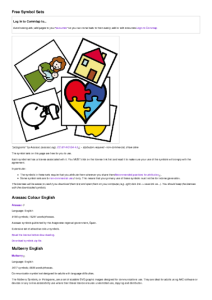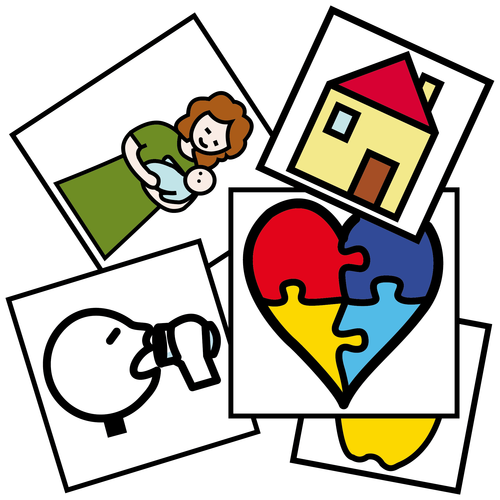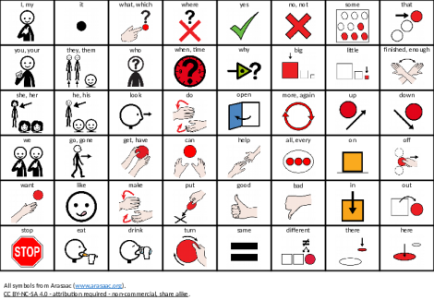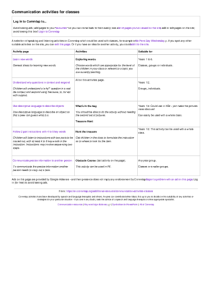Search
User login
Topic “Other expressive”
Core communication board
Core communication board using ARASAAC symbols (https://arasaac.org). For use with everyday communication.
Note: if re-distributing with the ARASAAC symbols, this must be done non-commercially only.
You can make your own core communication board using different symbols with the Commtap Symboliser for PowerPoint.
Created 25 June 2022; updated 6 December 2024.
Core communication boards
Full core communication board plus a simplified version. Uses Noun Project icons - can be used in any context as long as the icons are attributed.
Created 17 March 2022; updated 12 May 2025.
think and talk about events in the past and future
| Activity/strategy name and materials required | How to do the activity | Key principles for doing the activity and comments |
|---|---|---|
| Which day? Sheet of paper with 3 boxes drawn on them for yesterday, today and tomorrow. A counter. Optional: sets of symbol cards or pictures showing a variety of activities - including activities the student may have done. You can create symbols cards using the Commtap Symboliser for PowerPoint. | 1. Talk about each day, one at a time. Get the student to draw or write things they have done or will do in each box. Use the picture symbols if the student is having difficulty coming up with things. 2. When you have finished, explain that there is going to be a quiz. Describe an activity and the student must say if they did it yesterday, did it today or will do it tomorrow. 3. Have them step the counter over onto the right day. | This works best when there are key things which are different about each day! |
| The Story of Fred Set of three pictures - one showing a picture of a child, one showing a picture (preferably of the same person!) at a similar age to the student and one a picture of an older person. These could be photographs or drawings. Choose three ages which are appropriate/relevant for the student.
Large 'thought clouds ' on A3 or A4 paper: Sticky tape Pens Picture symbol prompts if required. You can create symbol prompts using the Commtap Symboliser for PowerPoint. | ||
| Calendar Calendar Pens | This is an ongoing activity. You could take photos of the key events, and put them on the calendar. | |
| Daily Schedule/Picture Schedule Any activity or set of activities where the student might use a schedule or have a visual timetable. You can create a visual timetable/schedule using the Commtap Symboliser for PowerPoint. |
Sequence three pictures related to hygiene
| Activity/strategy name and materials required | How to do the activity | Key principles for doing the activity and comments |
|---|---|---|
| Self Care Activities Camera to make the picture sequences (or alternatively you can draw them or use a commercial resource). Resources as appropriate to carry out a simple sequence Examples of sequences: Clean teeth: get toothpaste, open lid, get brush, squeeze toothpaste onto brush, put lid back onto toothpaste, brush teeth, spit out, put brush under water, repeat, clean brush, put brush away. Wash hands: turn on tap, rinse hands, put soap on hands, scrub hands, rinse under water, turn tap off, dry with towel. Brush hair: get brush, brush hair, put brush away. Deodorant: get deodorant, take off lid, spray at appropriate area, put lid back on, put away. | 1. Carry out the sequence without the pictures; 2. Do it again, showing the relevant picture for each part of the activity as you do it; 3. Get the student to do the sequence, showing them a picture for each part of the sequence as they do it; 4. Get them to show you what to do by giving you a picture for each part of the sequence. Try to do exactly as the picture you are given indicates, for example if they give you a picture of scrubbing your hands before the tap is turned on/before you have the soap, try to do this - but appear confused when this doesn't work. | At this level students may often be able to learn particular sequences of pictures without understanding that they relate to a sequence of actions, these activities are designed to address this issue. Seeing how the sequence goes wrong if the wrong picture is chosen (in step 4) will encourage the student to work out which should have been the right picture without you needing to give any further feedback. |
Share information about self with others
| Activity/strategy name and materials required | How to do the activity | Key principles for doing the activity and comments |
|---|---|---|
| Likes and dislikes Optional - something to record the students responses on (e.g. paper/pen) which can later be used as a prompt; Soft ball or beanbag. |
| To make it harder, you can go around again asking for favourite drinks - so that everyone now has to remember a food and a drink for each student when they pass the ball (e.g "Tim - you like carrot cake and tea"). You could use favourite games, favourite places to go, etc. instead. |
Talk about things in the recent past
| Activity/strategy name and materials required | How to do the activity | Key principles for doing the activity and comments |
|---|---|---|
| What have you done today? Optional - way of recording students responses - e.g. paper/pen, whiteboard/marker |
| Variations
|
| What have you done today - with a ball Optional - way of recording students responses - e.g. paper/pen, whiteboard/marker Soft ball or beanbag |
Communication activities for classes
Created 12 September 2012; updated 11 May 2023.
Communication activities for classes
A selection of speaking and listening activities on Commtap which could be used with classes, for example on No Pens Day Wednesday. If you spot any other suitable activities on the site, you can edit this page. Or if you have an idea for another activity, you could add it to the site.
Learn new words
| Activity/strategy name and materials required | How to do the activity | Key principles for doing the activity and comments |
|---|---|---|
| Exploring words Written word with a picture Written sounds for beginning/ end of each word Visuals for the story Dictionary (maybe)
| Ideas you can use to help word learning - you do not need to use all of them, and some will work better than others for different children. 1. Introduce the written form of the word; 2. Say the word to the child and ask for repetition; 3. Ask the child to clap syllables on your or their hands, use prompting if necessary. Or alternatively they could tap the syllables out on pictures of drums (say four arranged in a row); 4. Ask if any other words rhyme with this new word (think of examples yourself) - you could take this in turns in a group; 5. Ask for beginning and ending sounds; 6. Tell the child a short story or anecdote, including the word as the main feature if possible - or work with the child to work a story out; 7. Give an explicit definition (school dictionary maybe - some dictionaries are more helpful than others for this!) and give context(s) preferably first one being the one used in the story as it’s familiar but make sure to offer other contexts; 8. Ask the child if they can put the word in a sentence/ tell a short story including the word; 9. If ability allows, ask the child if they know of any word which means a similar thing. | These activities help to build a child’s vocabulary with solid representations of words. It gives a child strategies to use when learning and remembering new words. It builds the child’s confidence on a topic, especially if taught before the relevant lesson. |
use switches to turn something on or off
| Activity/strategy name and materials required | How to do the activity | Key principles for doing the activity and comments |
|---|---|---|
| Keeping cool: learning to sustain an action Fan, (with optional ribbons attached) Mains switch control box | Configure the controller so that the fan is on as long as the switch is held down. Hold down the switch and let the child/adult feel the breeze. Let them do the same. | The child/adult should experience holding down the switch and feeling the breeze. On release the breeze stops. State, "On" and "Off" as you and the child/adult press and release the switch. |
| Learning to use a switch to turn a device on Fan (as above) | As either of you press the switch say, "on." When it stops say "off." Show them the effect of the breeze, blowing your hair or rubbing your arms because it is cold. | |
| Switching a device on and off (Do this in a subsequent session after the child/adult has understood the process in the above activity). A device to control, for example: fan toy computer monitor bubble machine | Let the child/adult turn the fan on and off modelling the vocabulary as you go. Reinforce this learning with different devices at different times and places. |
make predictions about physical actions
| Activity/strategy name and materials required | How to do the activity | Key principles for doing the activity and comments |
|---|---|---|
| What would happen if? Selection of the following equipment as appropriate: Candle and matches/ lighter; Balloon and pin; Building bricks/ Jenga game; Jug and cups, access to sink; Glass, water and instant coffee granules | Using appropriate equipment, ask the child to predict what will happen, then carry out the action to see if they were right: What will happen if you... Touch a flame to the candle's wick? Hold the candle horizontally? Blow onto the candle's flame? Blow into the balloon? Touch the balloon with the blunt end of the pin? Touch the balloon with the sharp end? Put a large brick on top of a smaller brick? Build a tower using all the bricks? Pull out a brick from lower down the tower? Start the tower on an uneven surface? Put lots of water (more than it can hold) into a cup? Have the cup upside down when you try to fill it? Put some coffee granules in the glass, then add cold water? Fill the glass with water, then sprinkle coffee granules on the top? | |
| Science activities Equipment as appropriate to the science activity. |
Identify errors in pictures of everyday objects
| Activity/strategy name and materials required | How to do the activity | Key principles for doing the activity and comments |
|---|---|---|
| What is wrong? pictures Pictures of everyday objects and situations with errors, for example a picture of a house with the front door on the second floor, a picture of a phone with a banana instead of a handset, a someone using an umbrella with holes in it in the rain Commercially produced "What's Wrong?" cards are available. If you have any of your own pictures appropriate for this activity or you know of a link, please consider adding them to the site at www.commtap.org | 1. Have a look at the card and get the child to identify what is wrong or unusual about what is depicted on the card. 2. Get the child to talk about what problems could arise from the situation in the picture and how they could be resolved. 3. Get the child to relate the picture to their own experience. | If the child has difficulties, you can look surprised or puzzled when you see the picture, make comments like "there's something wrong", or "my phone's not like that", or "Oh no! He's getting wet!" To keep the child motivated they could also post the card once the card has been discussed. |
Counts up to 5 objects
| Activity/strategy name and materials required | How to do the activity | Key principles for doing the activity and comments |
|---|---|---|
| Activities from TAP sheet: "MN P6 counts to 3.doc" "Counts to 3" activities sheet on www.commtap.org. Materials as described on this sheet. | Use materials and activities described in this activities sheet. Extend the activities to go up to the number 5. | See the guidelines given on the sheet. |
Support Commtap to keep it online
Thank you for visiting Commtap.
Please read this message as it is extremely important.
- Visitor donations mean we can continue to host over 1,000 free activities to support speech, language, and communication development.
- Visitor donations mean we can continue to provide free resources to address a wide range of communication needs, including limited speech or language, interaction challenges, and needs associated with conditions such as developmental language disorder, autism, and cerebral palsy.
- Visitor donations mean we can continue to provide resources to support the work of speech and language therapists, teachers, teaching assistants, parents, and carers.
- Visitor donations mean we can continue to provide the free key word sign dictionary (bks.org.uk) which has over 2,000 Makaton and Signalong signs.
We know that not everyone is able to afford to pay to access these resources, however, if you can, please make a donation to keep the site going.
Thank you
Google ads on this page are provided by Google Adsense - and their presence does not imply any endorsement by Commtap. Report a problem with an ad on this page. Log in (for free) to avoid seeing Google ads.






